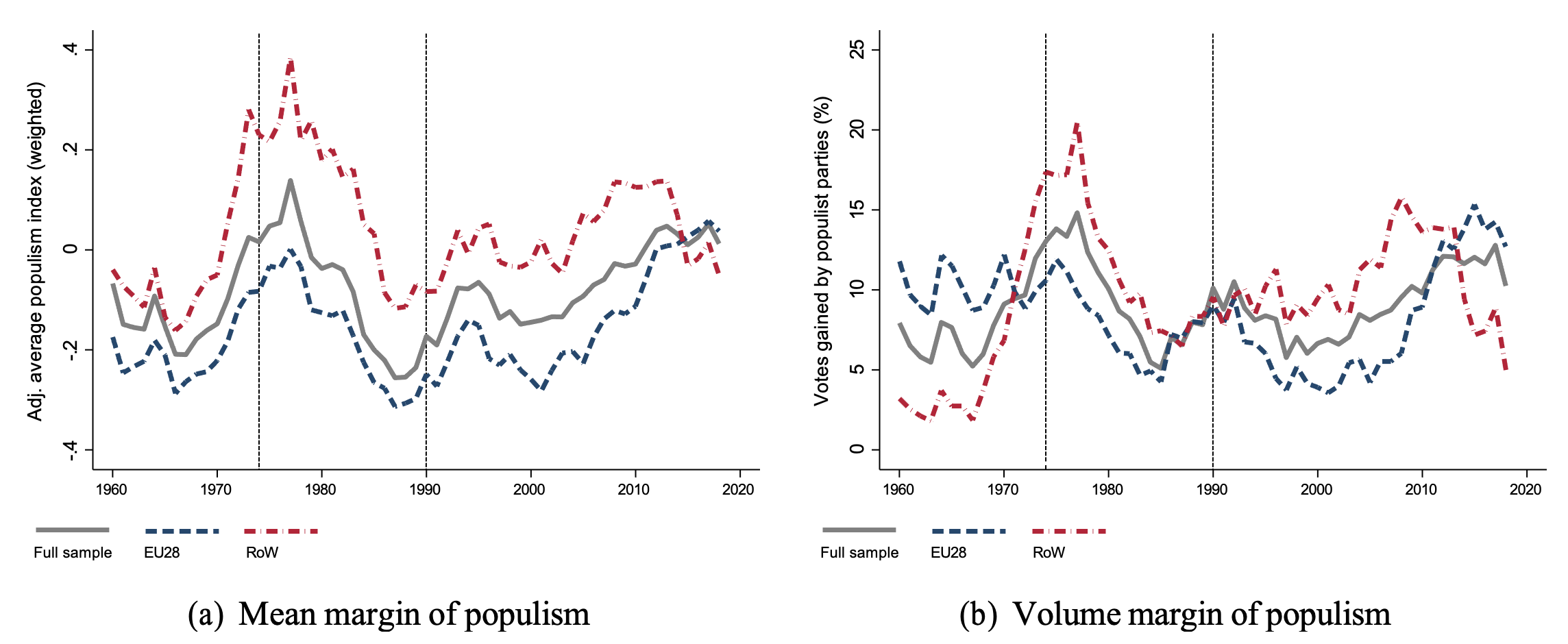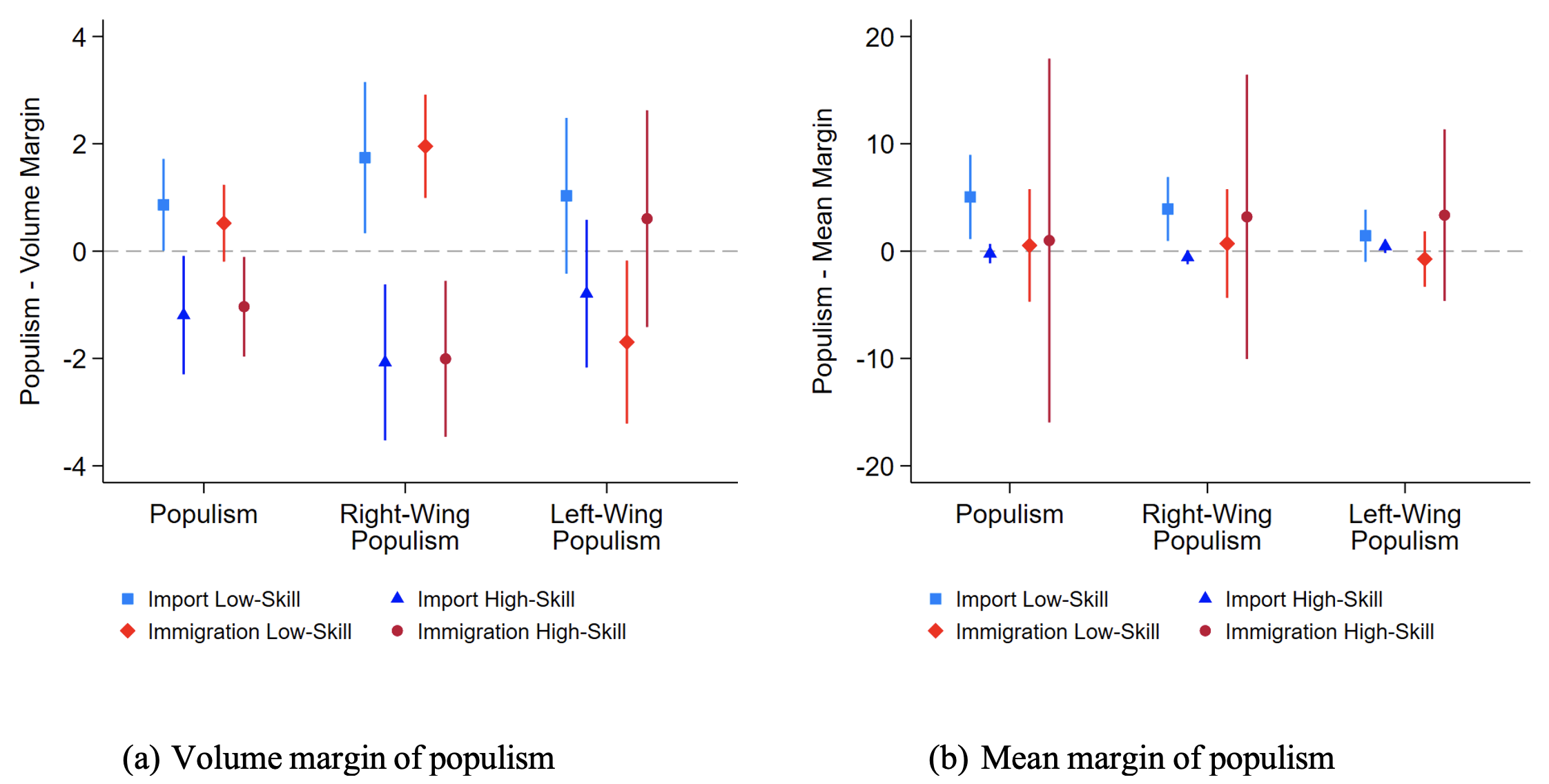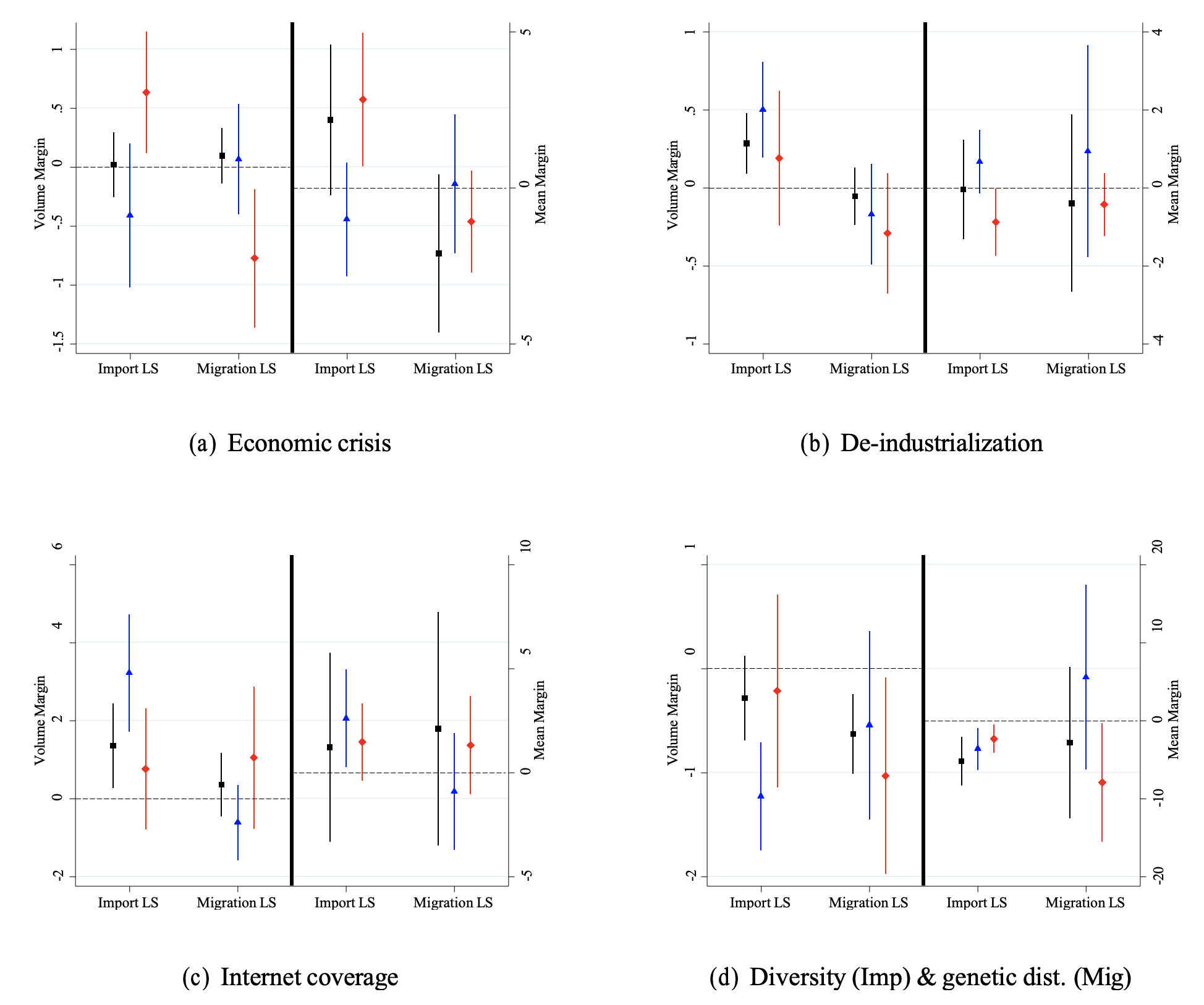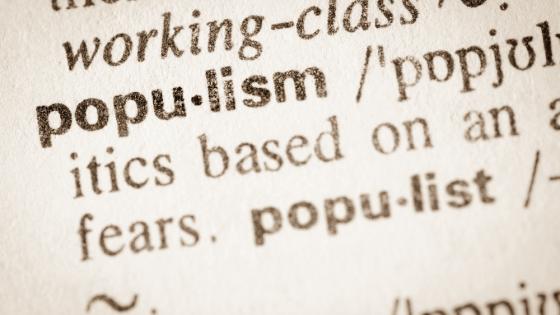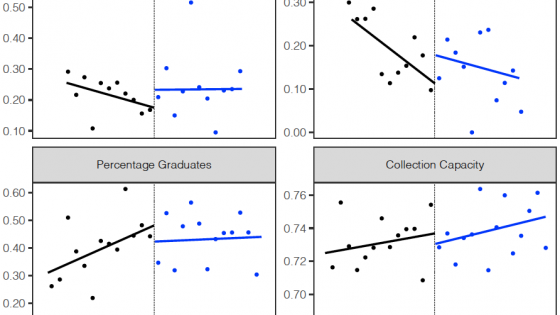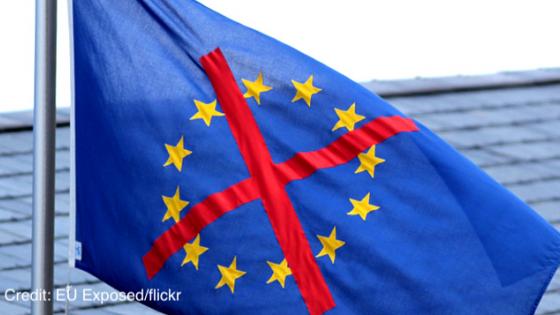It is important to analyse populism for what it implies for civil liberties and democracy. For economists, populism is also of interest from a macroeconomic perspective, as it negatively affects the economic performance of countries. Schularick et al. (2021) estimate that countries with a populist leader incur a 10% loss of GDP after 15 years compared to otherwise similar countries.
With 25% of all countries in the world now governed by a populist party or coalition, the global macroeconomic cost of populism is substantial. If populism affects the global economy, it is also affected by it: the recent rise of populism worldwide is largely seen as a backlash against globalisation (Guriev and Papaioannou 2022, Rodrik 2021).
In a recent paper (Docquier et al. 2024), we analyse the links between populism and globalisation and ask:
- Is it really the case that people who are more exposed (at the national level) to immigration and trade shocks vote more for populist parties?
- Does the skill content of those shocks matter?
The existing literature (Colantone and Stanig 2018, Autor et al. 2020, Mayda et al. 2022, Moriconi et al. 2022) offers only partial answers to these questions, in part because trade and immigration have so far been analysed separately (while our research shows they should be considered together) and in part because the skill-content of both has largely been ignored.
Our work consists of two parts: the measurement of populism and the analysis of its global determinants.
Measuring populism and its evolution
Quantitative studies of populism generally proceed in two steps. First, they define which parties are ‘populist’ based on the judgement of experts. Parties classified as populist tend to combine a strong anti-elite stance and a strong commitment to protect people against the evil forces of global capitalism (for left-wing populism) and cosmopolitanism (for right-wing populism).
In a second step, they measure populism as the sum of the vote shares of all populist parties. However, this approach neglects the fact that populist ideas are not restricted to populist parties and can be reflected, at least partly, in the platforms and programmes of mainstream parties. For example, in most classifications (including ours), the US Republican Party under the leadership of Donald Trump is not categorised as a populist party, while few observers would deny that Donald Trump himself is a populist leader.
Our contribution to the measurement of populism starts with the recognition that populism is a continuum rather than a discrete concept. We attribute a ‘populism score’ to all parties running in a given legislative election based on text analysis of their political platforms.
These scores reflect the salience of the anti-elite and the commitment-to-protect stances in a party’s political platform. Equipped with these scores, we can define a threshold (based on criteria extensively discussed in our paper) above which a party can be categorised as populist.
Second, while we follow the rest of the literature in using the sum of the vote shares of all populist parties represented in parliamentary elections as a measure of the ‘volume’ of populism, we propose a complementary measure computed as the vote-weighted populist scores of all parties, which we denote as our ‘mean margin’ of populism.
Figure 1 Evolution of populism: Volume and mean margins
Notes: Panel (a) plots mean margin of populism, computed as parties’ average populism score. Panel (b) presents the volume margin of populism, computed as the vote share for populist parties. Both figures show the moving averages including three years before and three years after each date.
Source: Docquier et al. (2024).
Figure 1 presents the evolution of the volume and mean margins of populism. Both margins have fluctuated since the early 1960s, often peaking in times of economic crises such as the oil crisis in the late 1970s or the great post-2008 recession. In 2018, populism was higher on average than in 1960 but lower than the peak observed in the late 1970s, with notable differences in evolution between Europe and the rest of the world. It is important to emphasise that the recent rise of populism in Europe comes from both the East and the West. Furthermore, while fluctuations in the mean margin up to the 1980s were primarily driven by parties categorised as populist, the recent surge is due instead to the dissemination of populist ideas among traditional parties. Outside of Europe, current levels of populism are lower than in the past, due mostly to the decline of left-wing populism. The evolution of the volume margin follows a similar pattern, with more pronounced trends due to the entry and exit of populist parties (the ‘extensive margin’ of populism).
Globalisation and its skill contents
We use our volume and mean margins of populism as dependent variables and investigate how they are impacted by the extent and type of globalisation shocks (that is, by skill-specific import competition and immigration shocks) experienced by voters.
We find that total, right-wing, and left-wing populism levels are very sensitive to the skill structure of globalisation shocks. First, if anything, imports of goods which are intensive in high-skill labour, as well as highly-skilled immigration, have a negative effect on the support for right-wing populism. An increase of 1 percentage point in the high-skill migration rate is associated with a 1.32-percentage-point decrease in the vote for right-wing populist parties.
Second, as far as low-skill globalisation shocks are concerned, immigration and trade shocks show different patterns: while imports of goods which are intensive in low-skill labour are associated with an increase of both right-wing and left-wing populism (e.g. an increase of 1 percentage point in low-skills imports generates a 1.49 decrease in left-wing populism), low-skill immigration affects left-wing and right-wing populism in opposite – and quantitatively comparable – ways: more right-wing populism, and less left-wing populism. In theory, this could be due to one of the following three possibilities: (i) parties switching from left-wing to right-wing populism, (ii) voters switching from left-wing to right-wing populist parties, or (iii) the whole distribution of voters shifts to the right in response to low-skill immigration shocks. We can rule out the first possibility with our data but need complementary data to discriminate between the others.
And third, we find that the mean margin of populism is significantly affected only when considering the effect of low-skill imports, which are shown to generate more right-wing populism.
These results are shown in Figure 2. Panel (a) focuses on the volume margin as an outcome, while panel (b) shows results on the mean margin.
Figure 2 Skill-specific globalisation shocks and populism – volume and mean margins reduced-form IV Poisson pseudo maximum likelihood and 2SLS results
Notes: Panel (a) plots the estimated coefficients of the skill-specific globalisation shocks on the volume margin of populism, while panel (b) presents the estimated coefficients of the skill-specific globalisation shocks on the mean margin of populism. 90% confidence intervals are reported.
Source: Docquier et al. (2024).
Our analysis also highlights the importance of jointly estimating the relationship between populism and skill-specific migration and trade shocks. In particular, the statistical significance of the results for low-skill imports is strongly impacted by the inclusion or exclusion of migration shocks, while the opposite is not true.
Finally, we explore the direct impact of other well-known determinants of populism and the way they interact with our variables of interest, i.e. trade and migration. Figure 3 illustrates our findings. Each sub-figure focuses on a potential amplifying or mitigating factor: economic crises, internet diffusion, and the diversity of trade partners/immigrants. We differentiate between the volume and mean margins of populism, with two sets of estimates within each panel: the impact of low-skill labour-intensive goods imports and low-skill immigration.
Figure 3 Interactions with amplifiers for volume and mean margins reduced-form IV Poisson pseudo maximum likelihood and 2SLS results
Notes: Black (square) objects: overall dimensions; blue (triangle): right-wing dimensions; and red (diamond) left-wing dimensions. Dependent variable is the volume margin on the left panels, the mean margin in the right panels. The estimates represent the coefficients of the interaction term between migration (LS) and imports (LS) with a dummy equal to one if the country experienced a year of negative real growth five years before the election year (panel a), as well as proxies for de-industrialisation (panel b), for internet coverage (panel c), and trade diversity and genetic distance (panel d). 90% confidence intervals are reported.
Source: Docquier et al. (2024).
We find that low-skill globalisation shocks are exacerbated during economic crises and periods of deindustrialisation, as well as during internet expansion. However, the impact is mitigated when there is greater diversity among trade partners and exacerbated when immigrants come from culturally more distant countries.
Altogether, our results confirm the need to jointly account for both dimensions of globalisation – trade and migration – and for their respective skill content when analysing the determinants of populism. They also suggest that the blame for the rise of populism cannot be laid on globalisation as a whole; it is essential to acknowledge that, with respect to populism, the effects of trade and migration are not mirror images of each other, and that low-skill and high-skill globalisation, if anything, have opposite effects on populism. Hence, any policy recommendations concerning trade restrictions (protectionism) or immigration should carefully weigh the diverse impacts of each, particularly in terms of their skill-specific content.
References
Autor, D, D Dorn, G Hanson, and K Majlesi (2020), “Importing political polarization? The electoral consequences of rising trade exposure”, American Economic Review 110(10): 3139–83.
Bellodi, L, F Docquier, S Iandolo, M Morelli, and R Turati (2024), “Digging up trenches: Populism, selective mobility, and the political polarization of Italian municipalities”, CEPR Discussion Paper 18778.
Colantone, I, and P Stanig (2018), “The trade origins of economic nationalism: Import competition and voting behavior in Western Europe”, American Journal of Political Science 62(4): 936–53.
Docquier, F, S Iandolo, H Rapoport, R Turati, and G Vannoorenberghe (2024), “Populism and the skill-content of globalization”, CEPR Discussion Paper 18822.
Feyrer, J (2019), “Trade and income: Exploiting time series in geography”, American Economic Journal: Applied Economics 11(4): 1–35.
Frankel, J A, and D H Romer (1999), “Does trade cause growth?”, American Economic Review 89(3): 379–99.
Guriev, S, and E Papaioannou (2022), “The political economy of populism”, Journal of Economic Literature 60(3): 753–832.
Mayda, A M, G Peri, and W Steingress (2022), “The political impact of immigration: Evidence from the US”, American Economic Journal: Applied Economics 14(1): 358–89.
Morelli, M, M Vannoni, and L Bellodi (2021), “Expelling the experts: The cost of populism for bureaucratic expertise and government performance”, VoxEU.org, 7 April.
Moriconi, S, G Peri, and R Turati (2022), “Skill of the immigrants and vote of the natives: Immigration and nationalism in European elections 2007–2016”, European Economic Review 141: 103986.
Rodrik, D (2021), “Why does globalization fuel populism? Economics, culture and the rise of right-wing populism”, Annual Review of Economics 13: 133–70.
Schularick, M, C Trebesch, and M Funke (2021), “The cost of populism: Evidence from history”, VoxEU.org, 16 February.






